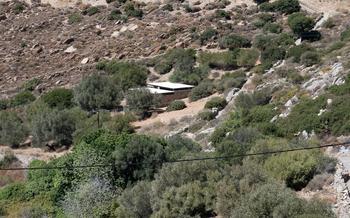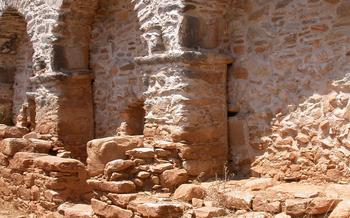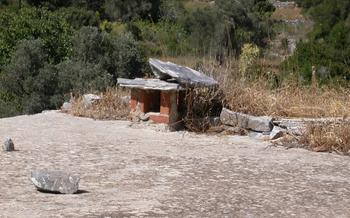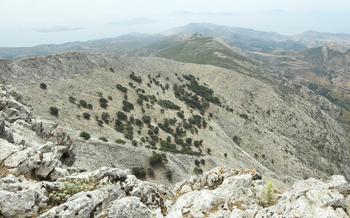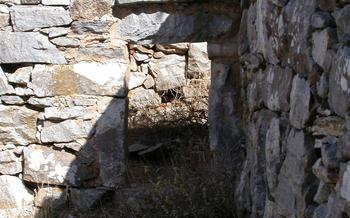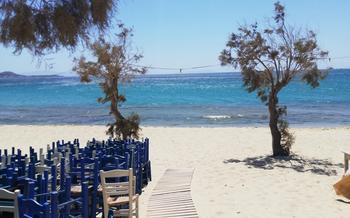
Agios Sostis Church
- Agios Sostis Church: A Historic and Cultural Gem in Naxos
- Location and Accessibility
- Interior and Artwork
- Religious Services and Events
- Panoramic Views and Surroundings
- Historical Context and Mythology
- Significance to Naxian Culture
- Restoration and Preservation Efforts
- Local Festivals and Celebrations
- Nearby Attractions and Activities
- Photography and Social Media
- Accommodation and Where to Stay
- Insider Tip: Discover the Hidden Beach of Panermos
Agios Sostis Church: A Historic and Cultural Gem in Naxos
Historical Significance
The Agios Sostis Church, nestled in the picturesque village of Agios Sostis on the enchanting island of Naxos, holds a significant place in Greek history and culture. Built in the 11th century, this Byzantine-era church stands as a testament to the rich religious and architectural heritage of Naxos. The church's unique architectural style, characterized by its domed roof and intricate stonework, reflects the influence of various civilizations that have shaped the island's history. Agios Sostis Church is not only a symbol of faith but also a reminder of Naxos's diverse cultural heritage, making it a must-visit destination for history and architecture enthusiasts.
Location and Accessibility
The Agios Sostis Church is situated in the picturesque village of Agios Sostis, on the southwest coast of Naxos. This charming village is a popular destination for both tourists and locals, known for its tranquil atmosphere, stunning beaches, and traditional Greek tavernas.
To reach the church, visitors can take a leisurely stroll from the center of Agios Sostis village, following the narrow cobbled streets that lead towards the sea. The church is conveniently located just a few minutes' walk from the main square, making it easily accessible for visitors of all ages and abilities.
Alternatively, travelers can take a scenic bus ride from Naxos Town, the island's capital. Buses depart regularly from the central bus station and offer a convenient and affordable way to explore the island's many attractions. Visitors should disembark at the Agios Sostis bus stop and follow the signs to the church, which is a short walk from the main road.
Interior and Artwork
The interior of the Agios Sostis Church is a testament to the artistry and devotion of its builders. The walls are adorned with exquisite frescoes that depict scenes from the Bible and the life of Saint Sostis. The colors are vibrant and the details are intricate, showcasing the skill of the artists who created them.
The most notable fresco is the one depicting the Last Supper. Jesus is seated at the center of the table, surrounded by his disciples. The expressions on their faces are lifelike and convey a sense of awe and reverence. The table is set with a variety of foods, including bread, wine, and fish. The overall effect is one of realism and beauty.
In addition to the frescoes, the church also features a number of mosaics and icons. The mosaics are located in the apse of the church and depict Christ Pantocrator, surrounded by angels and saints. The icons are scattered throughout the church and depict a variety of religious figures, including the Virgin Mary, Saint John the Baptist, and Saint Nicholas.
The artwork in the Agios Sostis Church is not only beautiful, but also historically significant. It provides a glimpse into the beliefs and practices of the early Christians in Naxos. The church is a living testament to the power of faith and the enduring legacy of Byzantine art.
Religious Services and Events
Regular religious services at the Agios Sostis Church are held weekly, typically on Sundays and religious holidays. During these services, the church fills with worshippers seeking spiritual guidance and a sense of community. Visitors are welcome to attend these services to experience the devout atmosphere and witness the rich traditions of the Greek Orthodox faith. It is important to be respectful and dress appropriately when attending religious services.
Special events and festivals are also held throughout the year at the Agios Sostis Church. These events often draw large crowds of locals and visitors alike. One of the most significant events is the annual panigyri (festival) held in honor of the church's patron saint, Saint Sostis. This festival typically takes place in August and features traditional music, dancing, and food. Visitors can immerse themselves in the vibrant Greek culture and witness the deep devotion of the local community.
Panoramic Views and Surroundings
As you stand in front of the Agios Sostis Church, let your gaze wander beyond its ancient walls. The church offers breathtaking panoramic views of the surrounding landscape, making it a true visual feast for visitors.
To the north, you'll be captivated by the deep blue waters of the Aegean Sea, stretching as far as the eye can see. The sparkling waves gently caress the sandy shores of Naxos, creating a picturesque coastline that will leave you in awe.
Turn your attention to the east, and you'll be greeted by the majestic silhouette of Mount Zas, the highest peak in the Cyclades. Its rugged slopes and verdant valleys create a striking contrast to the azure waters, adding depth and dimension to the scenery.
Facing south, you'll be charmed by the traditional whitewashed houses of Naxos Town, nestled amidst lush greenery. The town's vibrant atmosphere and lively harbor add a touch of modernity to this idyllic setting.
As the sun begins to set, the sky transforms into a canvas of vibrant colors, painting a magical backdrop for the Agios Sostis Church. The warm hues of orange, purple, and pink reflect upon the glistening waters, creating a moment of sheer enchantment.
Whether you're an avid photographer, a nature enthusiast, or simply someone who appreciates the beauty of the world, the panoramic views from the Agios Sostis Church are sure to leave an indelible mark on your memory.
Historical Context and Mythology
The construction of the Agios Sostis Church is deeply rooted in the historical and mythological tapestry of Naxos. In the 6th century BC, the Naxian tyrant Lygdamis sought to establish himself as a powerful ruler. To achieve this, he sought the guidance of the oracle at Delphi, who advised him to build a temple dedicated to Dionysus. Lygdamis followed the oracle's advice, constructing a magnificent temple in honor of the god of wine and revelry. This temple was believed to be the predecessor of the current Agios Sostis Church.
Over the centuries, the temple underwent several transformations, reflecting the changing religious and cultural landscapes of Naxos. In the early Christian era, the temple was converted into a church, dedicated to Saint Sostis. This transformation symbolized the merging of pagan and Christian traditions on the island. The church became a place of worship for the local community, serving as a spiritual and cultural center for generations.
Throughout history, the Agios Sostis Church has been associated with numerous myths and legends. One popular tale recounts the story of a young shepherd named Sostis, who was known for his exceptional piety. According to legend, Sostis was martyred during the persecution of Christians under the Roman Empire. His remains were later discovered, and a church was built on the site of his martyrdom, honoring his memory and his unwavering faith.
Significance to Naxian Culture
The Agios Sostis Church holds immense significance to the local community of Naxos. It serves as a spiritual and cultural hub, deeply interwoven with the island's history and identity. The church has witnessed generations of Naxians come together for religious ceremonies, festivals, and community gatherings. It is a place where traditions are upheld, and the spirit of Naxos is celebrated.
Throughout the centuries, the church has played a pivotal role in shaping the cultural landscape of Naxos. It has been a source of inspiration for local artists, musicians, and storytellers, who have drawn upon its rich history and symbolism to create enduring works of art. The church's annual festivals attract visitors from across the island and beyond, showcasing Naxos' vibrant cultural heritage through music, dance, and traditional cuisine.
For the people of Naxos, the Agios Sostis Church represents more than just a religious site. It is a symbol of their shared identity, a reminder of their ancestors, and a source of pride and belonging. The church's enduring presence in the heart of Naxian culture is a testament to its profound significance to the island and its people.
Restoration and Preservation Efforts
The Agios Sostis Church has undergone several restoration and preservation projects over the years to ensure its enduring beauty and historical significance. Recognizing the importance of preserving such cultural landmarks, local authorities and organizations have dedicated efforts to maintain the church's original features and protect it from the ravages of time.
One notable restoration project focused on reinforcing the church's structural integrity, addressing issues such as cracks and erosion. Skilled craftsmen employed traditional techniques to repair damaged stonework and strengthen the foundation, ensuring the church's longevity.
In another project, meticulous attention was given to restoring the church's vibrant frescoes and iconography. Experts carefully cleaned and restored these artworks, bringing back their original colors and intricate details. The goal was to preserve the artistic heritage of the church and allow visitors to appreciate the stunning visuals that adorn its interior.
Preservation efforts also extended to the surrounding landscape, with initiatives aimed at maintaining the natural beauty of the area. This included planting native vegetation, implementing sustainable practices, and raising awareness among visitors about the importance of respecting the environment.
These restoration and preservation efforts are essential in ensuring that future generations can continue to appreciate the beauty and cultural significance of the Agios Sostis Church. By safeguarding this historical treasure, the local community and visitors alike can continue to draw inspiration and spiritual enrichment from this sacred space.
Local Festivals and Celebrations
The Agios Sostis Church is not only a religious landmark but also a central part of the Naxian community. Throughout the year, several festivals and celebrations take place here that reflect the deep cultural and spiritual significance of the church.
One of the most notable events is the annual Agios Sostis Festival, held on August 28th. This vibrant festival attracts visitors from all over Naxos and beyond to celebrate the church's patron saint. The festivities include a grand procession carrying the icon of Agios Sostis through the cobblestone streets, accompanied by traditional music and dancing. Locals and tourists alike gather to participate in the procession, paying homage to the saint and seeking his blessings.
Another important celebration is the Epiphany, or "Theophania," on January 6th. During this festival, a unique ceremony takes place where a priest blesses the waters of the nearby sea. Locals and visitors gather at the shore to witness this symbolic ritual, which commemorates the baptism of Jesus Christ. After the blessing, brave souls take part in a swimming competition to retrieve a cross thrown into the water, believed to bring good luck and blessings to the finder.
These festivals are not merely religious events but also vibrant expressions of Naxian culture, where locals and visitors come together to celebrate their traditions and share in the joy of community. Whether you're a devout believer or simply seeking a glimpse into Naxian culture, attending these festivals is a truly enriching and memorable experience.
Nearby Attractions and Activities
After exploring the Agios Sostis Church, take some time to discover the surrounding area. Embark on a scenic walk along the picturesque coastline, enjoying the breathtaking views of the shimmering Aegean Sea. Immerse yourself in the beauty of nature by visiting nearby beaches, such as the secluded Agios Sostis Beach, renowned for its crystal-clear waters and golden sands.
For a culinary adventure, venture into the charming village of Filoti, known for its traditional Greek tavernas. Indulge in mouthwatering local delicacies, such as freshly caught seafood, succulent grilled meats, and delicious homemade pastries.
To delve deeper into the island's history and culture, visit the Naxos Archaeological Museum, which houses a fascinating collection of artifacts from Naxos' rich past. For a unique perspective, climb to the top of Mount Zas, the highest peak in the Cyclades, and enjoy panoramic views of the island and the surrounding sea.
Create a memorable day trip or extend your stay in Naxos to explore its other hidden gems. Discover the enchanting Venetian Castle of Naxos, stroll through the narrow streets of the old town, and immerse yourself in the vibrant atmosphere of the island's many festivals and events.
Photography and Social Media
The Agios Sostis Church presents a picturesque sight against the backdrop of the glistening Aegean Sea, making it a popular subject for photography enthusiasts. Capture the church's enchanting beauty in different lights throughout the day, from the golden hues of dawn to the warm glow of dusk. Don't forget to take advantage of the panoramic views from the surrounding hills, which offer breathtaking shots of the church nestled amidst the lush greenery.
Share your stunning photographs and experiences on social media using relevant hashtags like #AgiosSostisChurch, #Naxos, and #GreekIslands. Inspire your followers with captivating captions that convey the historical significance and spiritual essence of this sacred site. Tag the official tourism pages of Naxos and Greece to increase your visibility and connect with a broader community of travel enthusiasts.
Accommodation and Where to Stay
For a truly immersive experience, consider staying in one of the charming guesthouses or vacation rentals in the vicinity of the Agios Sostis Church. These accommodations often offer a more authentic and local feel, allowing you to connect with the Naxian culture and way of life. Look for properties with traditional Cycladic architecture, whitewashed walls, and stunning views of the Aegean Sea. Some popular options include the Naxos Resort Beach Hotel, the Galini Hotel, and the Villa Naxos. Remember to book your accommodation in advance, especially during the peak tourist season, to secure the best deals and availability.
Insider Tip: Discover the Hidden Beach of Panermos
For an unforgettable experience, venture beyond Agios Sostis Church to the secluded beach of Panermos, nestled just a short walk away. This hidden gem boasts crystal-clear waters, soft golden sand, and stunning views of the surrounding landscape. Take advantage of the tranquility and immerse yourself in the beauty of nature, enjoying a relaxing swim, sunbathing on the pristine shores, or exploring the fascinating rock formations that adorn the beach. Embrace the serene atmosphere and create lasting memories in this enchanting paradise.
